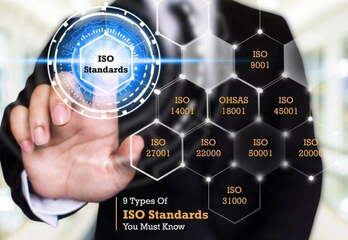

An Occupational Health and Safety Management System is in place for a company that has developed appropriate structures for identifying Occupational Risks, and for monitoring and continuously improving the reduction of Risk in its operating areas.
The necessary organizational structures are described in the international standard ISO 45001:2018 Occupational health and safety management systems. Requirements with guidance for use, which sets out the requirements for an Occupational Health and Safety Management System, with which a company can control Occupational Health and Safety issues, improve its performance and be certified.
The Occupational Health and Safety Management System includes a Description of its Organizational Structure, an Occupational Risk Assessment Study, Written Instructions for the tasks performed in the company and affecting Occupational Health and Safety, Forms and Documents that are applied, as well as Tools for Controlling and Assessing the Operation of the System.
The ISO 45001:2018 standard does not specify specific performance criteria for Health & Safety issues, nor does it provide detailed specifications for the design of a Management System.
PROSPERITY LTD, with many years of experience, undertakes the study and development of an Occupational Health and Safety Management System, which is then implemented by the interested company under the guidance of PROSPERITY LTD consultants. The Occupational Health and Safety Management System meets the requirements of the International Standard ISO 45001:2018.
The correct implementation of the System and the compliance with the requirements of the standard is audited by an independent Certification Body, which issues a certificate of conformity.
It should be noted at this point that PROSPERITY LTD does not simply carry out studies, but provides its clients with the know-how to design, implement and maintain an Occupational Health and Safety Management System. This means in simple words that PROSPERITY LTD trains the staff of Businesses/Organizations on the requirements of the ISO 45001:2018 standard and gives them the know how to use the tools it will provide them (Manuals, procedures, forms, Instructions, applications, etc.).
The time needed for the preparation and installation of a Quality Management System until certification ranges from 6 to 12 months depending on the readiness of the company concerned.
PROSPERITY Ltd. actively participates in all phases of the project and is responsible for the documentation of the Management System, as well as for the completion of the deliverables of each stage according to the requirements of the project schedule and will support the project until its completion, which is certification.
OCCUPANTIONAL HEALTH AND SAFETY IN GENERAL
Occupational Health and Safety (OHS) is often considered a “necessary evil”, in the sense that it creates additional costs for the business, because the requirements are imposed by law, without offering business benefits.
This view leads businesses to adopt an approach of compliance with the letter of the Law at the lowest possible cost (minimization of preventive measures).
The result of this approach is that OHS issues are not addressed preventively, but ex post, in a firefighting manner, after an accident or after an inspection by the Authorities.
The consequences of this approach become visible sooner or later with a series of negative results, such as human suffering, human losses, physical injuries, insurance compensation, delays, lost working hours, courts, business closures, etc.
Occupational risk prevention frees the company from the consequences and creates a safe and healthy working environment.
Approximately 10 million people working in the European Union, out of 150 million in total, fall victim to unsafe working conditions every year, while approximately 8,000 lose their lives.
In Greece, although there is a clear reduction in occupational accidents, approximately 25,000 workers are injured every year and over 250 are fatally injured.
Because accidents are an unpleasant event that every person avoids, we “exorcise” evil with perceptions such as “accidents do not happen in our company” or “there is no danger because our staff is experienced and careful”. However, many witnesses to accidents will confirm that these perceptions are completely wrong and that when evil does happen, it does not “go away”.
The perception that “the cost of improving working conditions is a luxury in today’s competitive environment” has also been proven to be completely wrong. The cost of subsequent treatment and rehabilitation has proven to be unaffordable for many companies.
The internal organization of a company in the field of OHS requires, at a minimum, the implementation of the legislative provisions that provide for the existence and operation of institutionalized bodies, such as the Safety manager, the Occupational doctor and the Health & Safety Committee.
However, because these bodies do not operate within the framework of a structured organization, but as independent uncoordinated bodies whose operation is imposed by the Law and not by the organizational structure of the company itself, the organization of the company in matters of Safety & Health is much more effective when there is a structured OHS Management System.
The philosophy of H&S Management Systems is based on the Deming cycle - Plan - Do - Check - Act for continuous improvement.